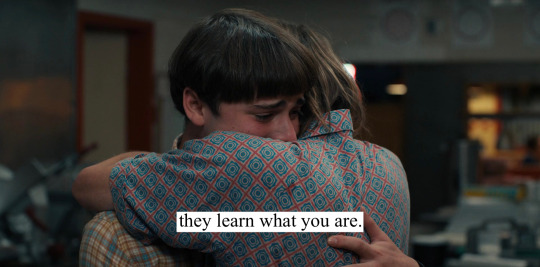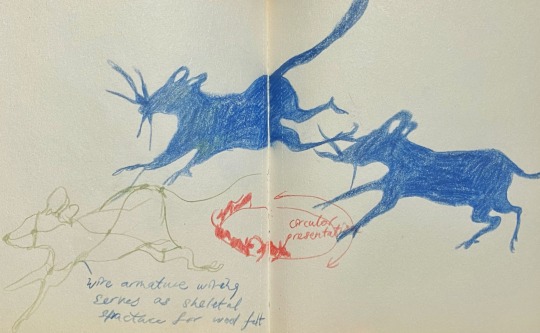Text
the autopsy team in every hannibal episode:

will graham:

33K notes
·
View notes
Text
how i feel when someone reblogs my stuff with a really really nice tag


69K notes
·
View notes
Text
Norwegian word order
Word order can be tricky to master in any language, and since I’ve had some questions about this recently (@wordsnnblues) I thought I’d make a post that covers the most important rules. This is simply a guide to the most common workings of Norwegian word order, and is unfortunately not exhaustive, but I tried to include the most important aspects.

Disclaimer: I’m not referring to this image in this post , so any letters that I use may not correspond to the ones used in the image! (I just thought it looked pretty :p)
The V2-rule
The main rule regarding Norwegian word order is that the finite verb (V) takes the second position* in the sentence. Some other parts are a bit more flexible, and there can be quite a few changes to word order depending on what element precedes the finite verb.
*Note that there is a difference between position and word. There can be several words in one position, for example in the first position, and thus, even though the verb must be in the second position, it can be later in the sequence in terms of words.
Main clauses
When the subject is fronted (SVO)
Putting the subject in the first position is the most usual way of constructing sentences in Norwegian, just like in English. The subject must then be followed by a verb according to the V2-rule above, which then can be followed by an object or adverb (or verb) as wished and depending on the characteristics of the finite verb.
Examples
Hun (S) spiser (V) = She (S) eats (V) / She (S) is eating (V)
Hun (S) spiser (V) mat (O) = She (S) eats (V) food (O)
Hun (S) spiser (V) fort (Adv.) = She (S) eats (V) fast (Adv.)
Hun (S) spiser (V) maten (O) fort (Adv.) = She (S) eats (V) the food (O) fast (Adv)
This is also valid for other tenses, just like in English:
Hun (S) spiste (V) mat (O) = She (S) ate (V) food (O)
Hun (S) har spist (V) mat (O) = She (S) has eaten (V) food (O)
Hun (S) skal spise (V) mat (O) = She (S) will/is going to eat (V) food (O)
Adverbial phrases in SVO sentences
In sentences where the subject is in the first position, adverbial phrases are usually placed straight after the verb. Adverbial phrases of time or place are usually placed in the last position. This applies for all tenses.
Some common general adverbials (A):
Ikke = Not Også = Also Kanskje - Maybe Aldri = Never Alltid = Always Dessverre = Unfortunately Sjelden = Rarely Ofte = Often Allerede = Already Fortsatt = Still
Some common adverbials of time (AoT)
I går = Yesterday I dag = Today I morgen = Tomorrow Nå = Now Neste/forrige uke/måned/år = Next/last week/month/year I fjor = Last year Denne gangen = This time Den gangen = That time
Some common adverbials of place (AoP)
Der = There Her = Here Dit = (To) there Hit = (To) here Hos … = At …’s (place) I … = In …,
Examples
Hun (S) spiser (V) ikke (A) kjøtt (O) = She (S) does not (A) eat (V) meat (O)
Hun (S) spiste (V) sjelden (A) kjøtt (O) = She (S) rarely (A) ate (V) meat (O)
Hun (S) har aldri (A) spist (V) kjøtt (O) = She (S) has never (S) eaten (V) meat (O)
Hun (S) skal kanskje (A) spise (V) kjøtt (O) = She (S) will maybe eat (V) meat (O) / She is maybe going to eat (V) meat (O)
Subject-verb inversion = When another (non-verb) element is fronted (VSO)
Sometimes you want to put another element in the first position, for example to add emphasis. In these cases, the finite verb and the subject switches places; the (finite) verb still remains in the second position and is followed by the subject. In English, the subject is placed in the second position and the verb follows it in the third position.
Examples
Nå (AoT) spiser (V) jeg (S) mat (O) = Now (AoT), I (S) am eating (V) food (O).
I går (AoT) spiste (V) jeg (S) kjøtt (O) = Yesterday (AoT), I (S) ate (V) meat (O)
I dag (AoT) har (V) jeg (S) gjort (v) lekser (O) = Today (AoT) I (S) have done (V) homework (O)
Denne (O) skal (V) jeg (S) spise (v) i morgen (AoT) = This one (O) I (S) will eat (V) tomorrow (AoT)
I Frankrike (AoP) spiser (V) de (S) ost (O) = In France (AoP), they (S) eat (V) cheese (O)
Adverbials in VSO / inverted sentences
In VSO sentences, the adverbial (A) is often placed after the subject, in the fourth position.
I går (AoT) spiste (V) jeg (S) dessverre (A) kjøtt = Yesterday, (AoT) I (S) unfortunately (A) ate (V) meat (O)
Hos besteforeldrene mine (AoP) får (V) jeg (S) alltid (A) godteri (O) = At my grandparent’s house (AoP) I (S) always (A) get (V) candy (O)
Når jeg drar på ferie (AoT) spiser (V) jeg (S) ofte (A) på restauranter (O) = When I go on holiday (AoT) I (S) often (A) eat (V) at restaurants (O)
The conjunctions “og”, “men��� and “for”.
og = and men = but for = because / as / since / for
These conjunctions link main clauses, and the word order does not change when these are used.
Examples:
Han (S) spiser (V) appelsiner (O), og (conj.) hun (S) spiser (V) epler (O). = He (S) eats (V) oranges (O) and (conj.) she (S) eats (V) apples (O)
Han (S) liker (V) kaffe (O), men (conj.) han (S) liker (V) ikke (A) te (O) = He(S) likes (V) coffee (O), but (conj.) he (S) does not (A) like (V) tea (O).
Jeg (S) kommer (V) ikke (A), for (conj.) mamma (S) kan (V) ikke (A) kjøre (v) meg (O). = I (S) am (V) not (A) coming (V), because (conj.) mom (S) can(V)not (A) drive (v)me (O).
Interrogative sentences
In Norwegian, like in English, questions are introduced by either a verb or an interrogative word.
In Norwegian, the most used interrogative words are:
Hva - What Hvem - Who Hvor - Where Hvorfor - Why Hvordan - How (When followed by verb. Only in regards to method/way of doing) Hvor … - How … (When followed by an adjective or adverb. In regards to extent, size and amount.) Hvilken/Hvilket/Hvilke - Which Hva slags - What kind
When using an interrogative word, this is placed in the first position, and the finite verb is placed in the second position.
Hva (Int.) spiser (V) du (S) ? = What (Int.) are (V) you (S) eating (v)?
Hvor mye (Int.) koster (V) det (S) ? = How much (Int.) does (V) it (S) cost (v)?
Without the use of an interrogative, the finite verb is placed in the first position and the subject second.
Spiser (V) du (S) kjøtt (O)? - Do (V) you (S) eat (v) meat (O)? / Are (V) you (S) eating (v) meat (O)?
Gjorde (V) du (S) leksene dine (O)? - Did (V) you (S) do (v) your homework (O)?
Adverbials in interrogative sentences
In interrogative sentences, the general adverbials are most often placed in the third position, after the subject.
Spiser (V) du (S) ikke (A) kjøtt (O)? = Do (V) you (S) not (A) eat (v) meat (O)?
Subordinate clauses
Subordinate clauses are dependent clauses that are often part of a main clause. they can be introduced by certain subjunctions.
Some common subjunctions:
fordi = because at = that om = if siden = since / as
Subordinate clauses remain SVO sentences, with the subject preceding the verb.
Jeg (S) studerer (V) norsk (O) fordi (subj.) jeg (S) har (V) en norsk venn (O) = I (S) study (V) Norwegian (O) because (subj.) I (S) have (V) a Norwegian friend (O).
Hun(S) sa (V) at (subj.) hun (S) liker (V) meg (O) = She (S) said (V) that (subj.) she (S) likes (V) me (O)
Adverbials
Although the word order remains SVO in subordinate phrases, the placement of the adverbial changes, from being straight behind the finite verb (V) in main clauses, to being straight in front of the finite verb in subordinate ones.
Main clause
Hun (S) liker (V) ikke (A) kaffe (O) = She (S) does (V) not (A) like (v) coffee (O)
Subordinate clause:
(Hun sier) at (subj.) hun (S) ikke (A) liker (V) kaffe (O) = (She says) that (subj.) she (S) does (V) not (A) like (v) coffee (O)
Adverbials
The placement of adverbials can vary a lot depending on what kind of meaning you want to convey, and also on what kind of adverbial you are dealing with, so the rules on adverbials that are mentionned in this post are not complete. I recommend everyone who is curious and want to know more about this to refer to this pdf, which I think deals well with the topic: https://tanuljunknorvegul.files.wordpress.com/2014/02/learn-norwegian-language-routledge-norwegian-an-essential-grammar.pdf.
Hope this is clear, and that I’ve not forgotten any major elements. Please feel free to correct any mistakes or typos, and don’t hesitate to ask further questions if anything remains unclear! <3
781 notes
·
View notes
Text




a place where someone loves you — neil hilborn
26K notes
·
View notes
Text
i love when i can see my bus waiting at a red light from the bus stop. come here babygirl
35K notes
·
View notes
Text
boy marx wasn't lying, the wealth of societies where the capitalist mode of production prevails sure does present itself as an immense accumulation of commodities
34K notes
·
View notes
Text
imagine you start watching this new show and it’s a silly little show about space set in the future then they announce the next season so you wait excitedly for five months and finally it’s here… you all sit round the tv and suddenly one of the main characters who is known for being unemotional starts going mad because of “biology…” and you slowly realise that he needs to have sex or he’s going to die so the other main character risks his entire career to help him out then they start ‘wrestling’ on the sand and the one going through the mating fever ends up killing the other guy which ends the fever but now he’s depressed because he just killed his best friend but wait he’s not actually dead the unemotional one is overjoyed everything’s fine and then they go back to work like nothing happened… you look at everyone else sitting in stunned silence thinking “did any one else think that was a little… yknow” then you accidentally start modern fandom and shipping culture
85K notes
·
View notes
Text
The way that most of Conan Doyle’s Sherlock Holmes stories’ most horrible villains are rich dudes that are abusive to women, in a time such as the 1880’s, compels me.
63K notes
·
View notes
Text
Top Gun is one of the most gay movies I’ve ever seen, I guarantee you someone had 5 awakenings during the volleyball scene
10 notes
·
View notes
Text
If I had a nickel for every time Patrick Stewart’s Professor X has been murdered on screen by a red-headed woman who used to be a hero who could read minds a little and had some telekinesis but then gained godlike powers to alter reality at will making her nearly unstoppable and eventually evil, I would have two nickels which isn’t a lot but it’s weird that it’s happened twice.
9K notes
·
View notes
Text
can’t believe there’s going to be a new generation of pjo fans who automatically picture walker scobell when they think of percy jackson and not a hodgepodge of viria and burdge’s fanart. does that make me old
26K notes
·
View notes
Text
Now give the donkey a drink of pure wine..... to wash down the figs..!


87K notes
·
View notes
Text
^_^ and >_< and also o_O and also T_T as well as >_> btw. if you care -_-
52K notes
·
View notes




